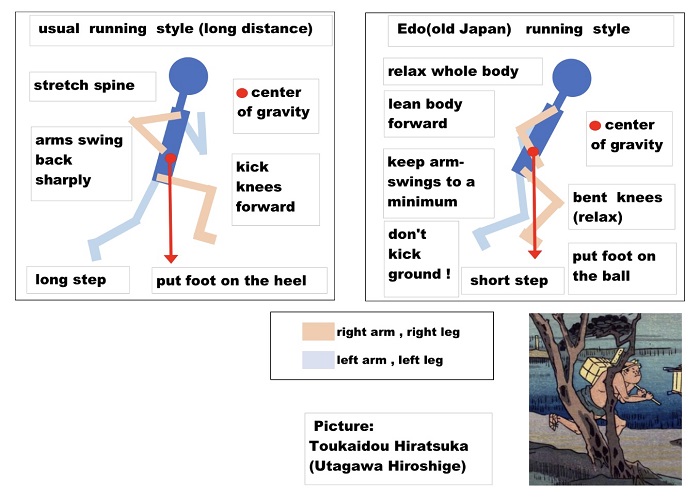3. Ninja Running Style

(I)Mechanics Influenced by Footwear and Clothing
①Japanese sandals such as zouri, geta, and waraji had no cushion on the sole.
So when people walked or ran,
they usually didn’t touch the ground with their heels.
Running in particular, could have caused damage to the heel,
so they would land on the balls of their feet to buffer the impact.
②Most people didn’t strike the ground with force with their feet when walking/running.
・In the “Shinsoku Hokou Jutsu”, it was very important to relax the whole body.
・Zouri, had no ankle strap so they could fly-off easily.
“Waraji” sandals, on the other hand, had ankle straps, but were made of straw.
The weaker construction meant there was a risk of breaking if they struck the ground too forcefully.
・Traction was also probably an issue
when trying to run in wet, icy, or muddy conditions.
Due to the aforementioned information,
I assume that they didn’t strike the ground with much force when running.
③They kept their torsos as straight as possible.
If the torso twists or moves too much,
the kimono will become disheveled and make it hard to continue running.
This is why I believe they would keep their torso as straight as possible when running.
④When a leg came forward,
the knee faced outward and the hip joint rotated outward.
When the leg swung back,
the knee straightened and the hip joint rotated inward.
The legs and arms should move in unison together
(when the left leg moves forward, the left arm should move forward with it).
I couldn’t find these movements mentioned in any of the source documents,
however based on trying these the styles described while wearing traditional footwear and clothing,
I believe my descriptions to be accurate.
(II)Combing Techniques
- Feet should hit the ground with the balls of the feet landing directly beneath the body with the knees bent
- The entire body should be relaxed
- The legs should spring quickly off the ground (vs striking with power)
- The legs and arms should move in unison together
- When swinging the arm forward, the wrist should rotate outward
(inward when pulled back)
- Eyes should be kept looking forward (about 1 meter ahead)

This type of movement is known as “Namba Hashiri” or "Namba running" today.